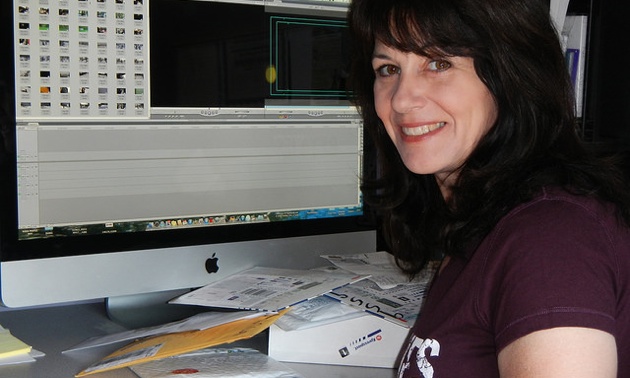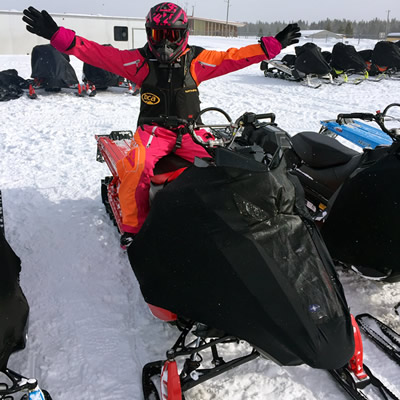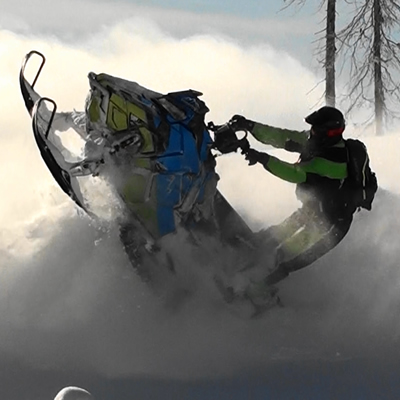When does the snowmobile season begin, and when does it end? Some feel season begins with the onset of the well-visited Haydays and the many snowmobile shows in September, October and November. Is that the beginning? For many dedicated snow-passionate individuals, it never truly ends. The summer months are spent planning and securing grant applications, revisiting management agreements and fighting the never ending battles of land issues and pending closures. This summer has been a busy one for most snowmobile clubs, with the National Trails Coalition trail initiative funding consuming endless hours of preparation to meet the very quick deadline of August 15th. We've had six weeks to prepare in the off season … what off season?
I sit, staring at my desk, bombarded by paperwork. My phone rings non-stop, along with hundreds of emails. My kids give me “that look.” The look is one that says, "Mom are you seriously on yet another conference call?" Roll eyes … face palm … the whole shebang. For many dedicated individuals who work hard to secure our sport for generations to come, the onset of snow is simply a part of the snowmobile season, certainly not the beginning. There really isn’t an end.
I asked Donegal Wilson, administrator for the British Columbia Snowmobile Federation, for a quote on how relaxing the summer months are: you know, the time we get to bask in the sun, eat bon bons and ease our mind of all worries and concerns relating to snowmobiling. She laughed. With no snow, there isn’t anything to do, - right?
Wilson said “Believe it or not, summer is the busy time. By the time skis hit snow, most of the work is done. December is our slowest month ... that way we get to enjoy the fruits of our labour.”
Organized snowmobiling is the core foundation of our sport, but it is estimated that only ten percent of snowmobilers are members of a club. We have much work to do, and a limited amount of manpower to do so. Who fights for land? Who delivers safety and stewardship messages? So many individuals work hard to preserve riding areas and to reach out with messages of safety and stewardship while promoting our sport in a positive light. Many of these passionate riders are unknown heroes who seek nothing more from their efforts other than knowing they are making a difference.
Curtis Pawliuk, General Manager of VARDA, had this to share: “The organized individuals and groups that come together for the benefit of our sport are key to our success and may often go unrecognized. The work that it takes to maintain major riding areas and infrastructure may not be completely understood. It's not as simple as running groomers, plowing snow and cutting firewood; it is a year-round operation. When the snow finally melts and we put away our machines for the year (often not until mid-June), that’s when the important maintenance begins. We have road systems, cabins, trails and vast alpine riding areas that all need attention. The importance of the work that clubs, their volunteers and staff do is crucial to a smooth flowing and positive winter experience. If we show up in December expecting to groom and we just then realize that we had a major water event and our road fell off the side of a mountain, that’s not good. And it's not all dirt, shovels and chainsaws either – there is a huge amount of work that begins behind the scenes as soon as the winter season ends. There are reports to write, provincial agreements to update and maintain, grants to find, partnerships to build etcetera, and this all leads directly into the next snowy season. When is the downtime you ask? Its when we get a chance to get out to the alpine on our sleds and enjoy everyone’s hard work. What can you do to help? Please join a club and support the groups that maintain your riding areas.”
These champions for the sport may or may not be the people you see in film. More often than not, they are far from the spotlight, but sometimes, people like Jeremey Hanke choose to use his popularity to send messages of stewardship and safety. Hanke is a member of the Revelstoke and Sicamous snowmobile clubs and a featured rider in many snowmobile films. He is also a very outspoken advocate of Avalanche Skills Training (AST). Through his company Soul Rides, Hanke not only teaches AST 1, but he also mentors riders into wise choices and skills development. “My AST 1 classes are more than just avalanche skills training. It is like AST 1.5, where participants learn about avalanche safety, but also very necessary ridership skills” Hanke said.
Hanke's story is one that hits home: in 2004 he was buried in an avalanche but was rescued by his riding companions. Knowing there were many choices that could have been made to avoid that tragedy, he became a strong voice for snowmobilers. By sharing his heartfelt message, he knew he could make a difference, and so began his journey into mentoring riders into safety. Hanke had a career in oil and gas, but this man is led by his heart. His heart wants to make a difference, so although there are many higher paying career choices he could make, he has decided to live a life making a difference. There is no off season for Hanke: he goes all out 12 months of the year, using the off season to develop curriculum, foster projects such as the educational resource Throttle Decisions and act as a voice for snowmobilers to Avalanche Canada, ensuring that our voice is being heard. He truly is a non-stop superpower when it comes to making a difference in the sport of snowmobiling.
Tamara Osborne is another passionate individual with no off season. She is the founder and club president of The Betties Powersports Network and produces the yearly Bettie Adventures films. As part of this project I do what I can to offer support to Osborne. In all honesty, dealing with all of these women who are passionate about powersports can be like herding cats. She relies upon footage submissions to create the films, with constant pressures from eager participants and fans. “When is the teaser going to be released?” is a question asked at least one hundred times before the end of the summer months. Dedicated to reaching out to all women passionate about powersports, Osborne pushes on, sometimes on a shoestring budget, because she believes in what she is doing. She believes that we are making a difference and creating a strong foundation for women in powersports.
One July afternoon I changed my Facebook cover shot to me carving a line around a tree. It wasn’t long before I had my non-snow-loving friends giving me the gears: “Trish, what are you doing! Summer is short enough! Stop posting snow pictures!” My answer was, “I need to. I have to remind myself why I am so involved in the volunteerism of snowmobiling. That picture ... it’s my sanity. To all of those who sacrifice their own personal time for the sport of snowmobiling, thank you. We all are one, and together, we can all make a difference.







